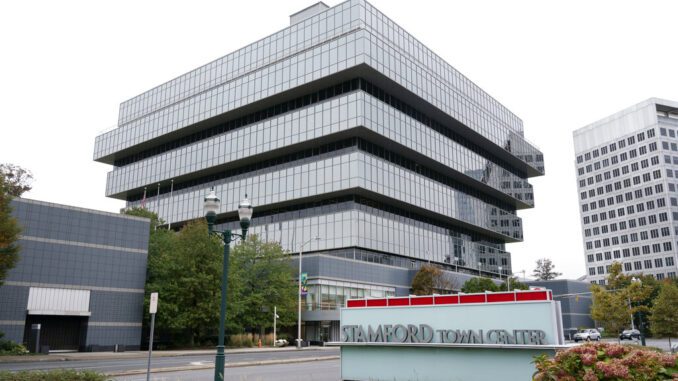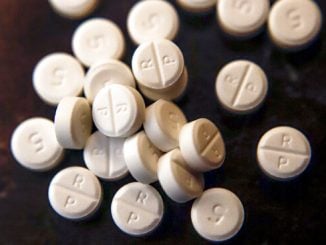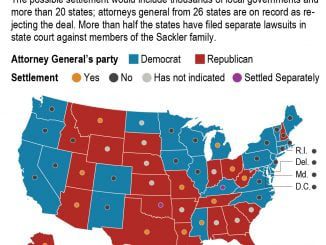
Purdue Pharma, which helped revolutionize the prescription painkiller business with its drug OxyContin, is proposing a $10 billion plan to emerge from bankruptcy that calls for it to be transformed into a different kind of company funneling profits into the fight against the nation’s intractable opioid crisis.
Those efforts would include a significant boost — more than $4 billion — from members of the Sackler family who own the Connecticut-based pharmaceutical giant.
The plan, filed late Monday night in U.S Bankruptcy Court in White Plains, N.Y., after months of negotiations, marks the company’s formal offer to settle more than 2,900 lawsuits from state and local governments, Native American tribes, hospitals and other entities.
“Purdue has delivered a historic plan that can have a profoundly positive impact on public health by directing critically-needed resources to communities and individuals nationwide who have been affected by the opioid crisis,” Steve Miller, chairman of Purdue’s Board of Directors, said in a statement.
Most of the parties in the case are on board with the plan. But attorneys general representing 23 states and the District of Columbia issued a statement saying the offer “falls short of the accountability that families and survivors deserve.” They want more money from the Sackler family members and for Purdue to wind down in a way that “does not excessively entangle it with states.”
The group includes most of the Democratic attorneys general across the U.S. and Idaho Attorney General Lawrence Wasden, a Republican.
“The Sacklers became billionaires by causing a national tragedy. Now they’re trying to get away with it,” Massachusetts Attorney General Maura Healey said in a statement. “We’re going to keep fighting for the accountability that families all across this country deserve.”
The true size of the family’s fortune is unclear. An earlier court filing said family members received transfers of $12 billion to $13 billion from Purdue over the years, though a lawyer said much of that went to taxes or was reinvested in the company. In letters to the U.S. House Oversight Committee last week, the two branches of the family that own the company said the family members who were board members had net assets of far less — about $1.1 billion.
Most of Purdue’s plan is similar to what the company proposed a year and a half ago when it first sought bankruptcy protection, a move that halted lawsuits against both the company and Sackler family members, who would continue to be insulated from legal claims under the plan.
In its proposal, the company said the Sackler family members would contribute nearly $4.3 billion over a decade, the company would kick in $500 million upfront, and its sales would generate another $1 billion through the end of 2024, when the plan is to sell or otherwise transform the company again. It says additional money would come from insurance claims.
Purdue said it will also provide overdose antidotes and anti-addiction drugs that would have a value of more than $4 billion.
The company replacing Purdue would be indirectly owned by two new trusts — one representing state and local governments’ interests and one representing Native American tribes. Future profits would go to the government entities and to pay for monitoring the health of children born in opioid withdrawal. Governments would be required to use their share for treatment, drug education and other opioid abatement programs.
Individual victims and their families would share $700 million to $750 million over time. With nearly 135,000 such claims, that would work out to average payments under $5,600. Personal injury payments are expected to range from $3,500 to $48,000.
Parties with claims against Purdue have until later this year to vote on whether to accept the new plan, which also calls for the creation of a public repository of the company’s documents.
Purdue began selling OxyContin 25 years ago, encouraging doctors to drop long-held reservations about opioids and focus more on easing the pain of patients. Court documents show company officials continued to push to maintain sales even as it became clear the drug was being abused.
More than 470,000 deaths in the U.S. since 2000 have been linked to opioids, including both prescription drugs and illegal ones such as heroin and fentanyl. The U.S. topped 50,000 opioid-related overdose deaths for the first time in 2019, and several states last year reported a record pace of overdose deaths due to all drugs.
Complicated litigation is playing out in courts across the country in efforts to hold the drug industry accountable, including in thousands of cases filed in federal court being overseen by one Cleveland-based judge. Purdue was removed from those cases and others when it filed for bankruptcy protection.
Trials in state and federal cases are scheduled to begin this year in California, New York, Ohio and West Virginia.
Separately, Purdue has pleaded guilty to federal criminal charges and settled civil complaints. The company’s federal agreement is valued at more than $8 billion. But the U.S. said the company had to pay it only $225 million as long as company funds are used to abate the opioid crisis; the plan filed Monday appears to comply.
In a separate federal deal announced at the same time, Sackler family members agreed to pay $225 million to the federal government but admitted no wrongdoing.



